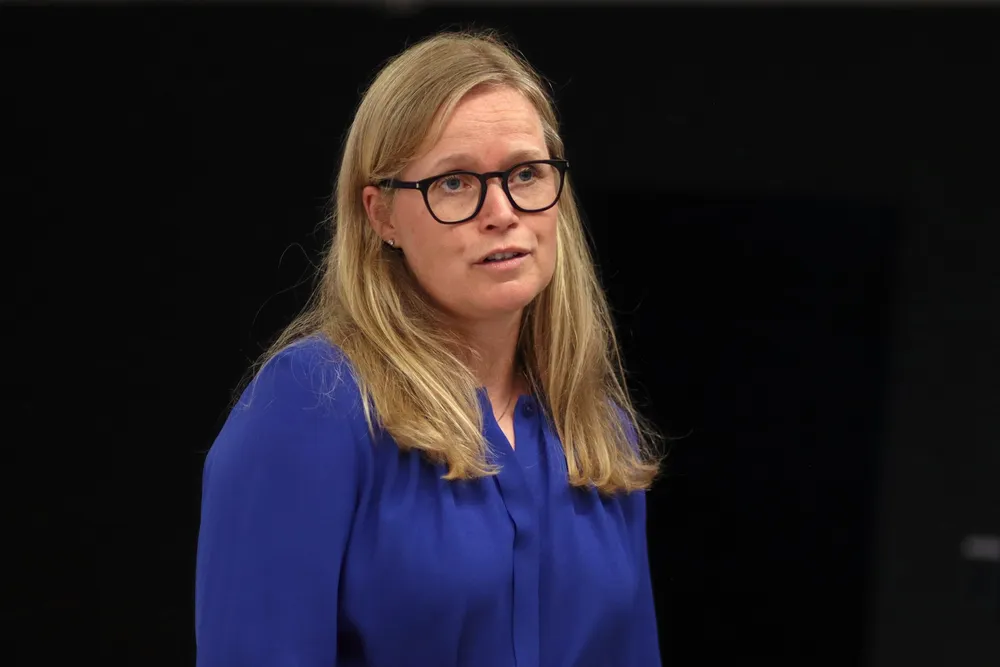Statkraft CEO explains wind strategy after bruising results
Apart from one bottom-fixed project in Ireland, Birgitte Ringstad Vartdal wants Statkraft to expand wind operations on land – for now.

Statkraft is the biggest European producer of renewable energy, mostly due to its hydro power operations in Norway and Sweden. But it is also among the top ten wind producers in Brazil and Spain.
Short-term, wind is causing headaches. In the Q2 results presented Tuesday morning, lower price expectations and lower output led to impairments on wind power in Sweden and Norway of roughly 3bn NOK ($296M). Statkraft had a significant loss after tax in the last three months, a very rare experience for the state-owned renewables giant.
However, she is also very clear about what Statkraft should and should not engage in:
- No floating wind for the “next few years”.
- The North Irish Sea Array is the only bottom-fixed project for now.
- Onshore, Statkraft will continue developing new projects in at least six countries.
The company’s wind portfolio spans large-scale developments, repowering initiatives, and hybrid projects. In Brazil, Statkraft recently completed the 519 MW Ventos de Santa Eugênia complex, its largest wind farm outside Europe.
Operational excellence: Learning from each other
Vartdal emphasised that there are advantages to comparing operations in Northern Europe with those in South America. What works well in one place can be adopted elsewhere. Norway, for instance, can learn from Brazilian operations.
“We have good competence in development and operations,” Vartdal said. “We compare performance across regions and learn from each other.”
Hybridisation is becoming more important to counter price fluctuations. In Northern Europe, the spot market is increasingly struggling with negative prices – mostly when solar production reaches peak levels.
Building wind and solar together may therefore be a good idea, as their production profiles tend to differ significantly. Batteries also come into this hybrid mix.
“Due to the different production profiles and grid connection limitations, hybrid projects are beneficial,” Vartdal said.
Statkraft is currently finalising its first hybrid wind-solar project in Brazil and has launched a solar-battery hybrid in Zerbst, eastern Germany, where a 47 MW solar park is combined with 16 MW of battery storage.
Battery storage is also being considered alongside wind.
“We see batteries both with wind and potentially with solar. It depends on the market,” she said. “We’ve seen it more often with solar, but we don’t exclude it for wind.”
Overall, Vartdal says Statkraft is developing new projects onshore in Germany, Spain, UK, Ireland, Sweden and Norway.
Repowering in European markets
Repowering is another strategic pillar. In Germany, Statkraft is upgrading older wind parks with newer, more efficient turbines. Similar repowering projects are also underway in Norway.
“There are many smaller wind parks around Germany where we do the same as in Smøla – replacing older turbines with new ones,” Vartdal explained.
The company’s approach varies by market. In Ireland, Statkraft has developed wind farms under government contracts and sold them post-completion.
“We have developed a lot of wind power in Ireland, built with contracts to the authorities, and sold after completion,” she said.
While Statkraft traditionally builds and operates assets, it is increasingly open to selling projects.
“We have done and do that in some markets. We aim to build and own long-term, but sometimes other investors are willing to pay more than we would to own,” Vartdal said. “It’s about optimising our total portfolio.”
Quite recently, the Norwegian industrial company Hydro was granted €80m in compensation from a wind farm that was unable to deliver the agreed level of power. It is the second time in two years that a wind power producer has failed to meet contract terms with Hydro.
Statkraft has largely sidestepped this issue, as it uses “market competence and combined production, so we don’t necessarily sell power directly from a wind park to a customer,” Vartdal explained. “Or if we do, we supplement with other power sources to meet total demand.”
One exception to the no-offshore rule
Floating offshore wind has been put on hold after Statkraft announced it would not participate in the upcoming tender for Utsira Nord in the Norwegian economic zone of the North Sea.
“We’ve said we won’t prioritise offshore wind going forward, except for NISA, a fixed-bottom project in Ireland,” Vartdal confirmed.
Statkraft was awarded the North Irish Sea Array in the first auction of the Irish government two years ago. The 500MW project is expected to start construction in 2027. This is in partnership with investor Copenhagen Infrastructure Partners (CIP).
Statkraft is essentially playing a waiting game for offshore wind.
“Learning comes from scale, but inflation, interest rate hikes and general market conditions affect floating wind too,” the CEO added.
Vartdal was appointed early last year, after running the Nordic operations in Statkraft for several years. She immediately sharpened company strategy.
Statkraft’s revised strategy reflects broader market realities. The company is reducing complexity and focusing on profitable technologies and regions.
“We will concentrate on our core competitive advantages and prioritise investments in near-term profitable opportunities,” the interim report states.
The company plans to invest NOK 16–20 billion annually, with wind power remaining a key component. In Europe and South America, Statkraft will continue to grow in wind, solar, batteries and grid services, though at a slower pace than planned before Vartdal took over.
Statkraft’s international wind strategy is shaped by local market needs.
“In South America, it depends on what the local market demands most,” Vartdal said.
Statkraft’s wind strategy is not just about technology – it’s about timing and market fit.
“We need to think through the power needs in different regions,” Vartdal said. “We continue to develop projects, but we must assess them in the context of our overall portfolio.”
(Copyright)